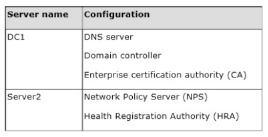READ Free Dumps For Microsoft- 70-411
| Question ID 14063 | Your network contains an Active Directory domain named contoso.com. All servers run
Windows Server 2012 R2. The domain contains two servers. The servers are configured as
shown in the following table.

All client computers run Windows 8 Enterprise.
You plan to deploy Network Access Protection (NAP) by using IPSec enforcement.
A Group Policy object (GPO) named GPO1 is configured to deploy a trusted server group
to all of the client computers.
You need to ensure that the client computers can discover HRA servers automatically.
Which three actions should you perform? (Each correct answer presents part of the
solution. Choose three.)
|
| Option A | On all of the client computers, configure the EnableDiscovery registry key.
|
| Option B | In a GPO, modify the Request Policy setting for the NAP Client Configuration.
|
| Option C | On Server2, configure the EnableDiscovery registry key.
|
| Option D | On DC1, create an alias (CNAME) record.
|
| Option E | On DC1, create a service location (SRV) record.
|
| Correct Answer | A,B,E |
Explanation Explanation: Requirements for HRA automatic discovery The following requirements must be met in order to configure trusted server groups on NAP client computers using HRA automatic discovery: Client computers must be running Windows Vista with Service Pack 1 (SP1) or Windows XP with Service Pack 3 (SP3). The HRA server must be configured with a Secure Sockets Layer (SSL) certificate. The EnableDiscovery registry key must be configured on NAP client computers. DNS SRV records must be configured. The trusted server group configuration in either local policy or Group Policy must be cleared. http: //technet. microsoft. com/en-us/library/dd296901. aspx
| Question ID 14064 | Your network contains an Active Directory domain named contoso.com. The domain
contains a virtual machine named Server1 that runs Windows Server 2012 R2.
Server1 has a dynamically expanding virtual hard disk that is mounted to drive E.
You need to ensure that you can enable BitLocker Drive Encryption (BitLocker) on drive E.
Which command should you run?
|
| Option A | manage-bde -protectors -add c: -startup e:
|
| Option B | manage-bde -lock e:
|
| Option C | manage-bde -protectors -add e: -startupkey c:
|
| Option D | manage-bde -on e:
|
| Correct Answer | D |
Explanation Explanation: Manage-bde: on Encrypts the drive and turns on BitLocker. Example: The following example illustrates using the -on command to turn on BitLocker for drive C and add a recovery password to the drive. manage-bde on C: -recoverypassword